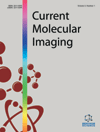- Home
- A-Z Publications
- Current Molecular Imaging (Discontinued)
- Previous Issues
- Volume 1, Issue 1, 2012
Current Molecular Imaging (Discontinued) - Volume 1, Issue 1, 2012
Volume 1, Issue 1, 2012
-
-
Receptor-Specific Peptides for Targeting of Liposomal, Polymeric, and Dendrimeric Nanoparticles in Cancer Diagnosis and Therapy
More LessAuthors: Dalip Sethi, Mathew L. Thakur and Eric WickstromCancer is uncontrolled growth of an abnormal mass of cells. Cancerous cells exhibit differential expression of receptors, as compared to healthy cells, which can be employed to deliver imaging and/or therapeutic agents specifically to the tumor tissue. Specific targeting of proteins on cancer cells for molecular imaging by nanoparticles loaded with multiple reporters can enhance the sensitivity of cancer detection over non-tar Read More
-
-
-
Strategies for Target-Specific Contrast Agents for Magnetic Resonance Imaging
More LessAuthors: Sashiprabha M. Vithanarachchi and Matthew J. AllenThis review describes recent research efforts focused on increasing the specificity of contrast agents for proton magnetic resonance imaging (MRI). Contrast agents play an indispensable role in MRI by enhancing the inherent contrast of images; however, the non-specific nature of current clinical contrast agents limits their usefulness. This limitation can be addressed by conjugating contrast agents or contrast-agent-loaded carrier Read More
-
-
-
Targeting Molecular Imaging of Breast Cancer by Radioimmunodetection Method in Nuclear Medicine
More LessAuthors: Zahra Heidari and Mojtaba SaloutiEarly diagnosis remains the best method of improving the odds of curing breast cancer. Mammography is an effective imaging tool in diagnosis of breast cancer. However, false negatives occur frequently, particularly when imaging post-surgical recurrence, fibrocystic breast disease and dense breast tissue in younger women. Other imaging modalities such as ultrasonography, magnetic resonance imaging and computed tomog Read More
-
-
-
Imaging Functional Beta Cell Mass: Can we See Islets Clearly Now?
More LessBeta cell mass is dynamic, and changes during neonatal growth and development, during pregnancy, and in response to chronic metabolic stress, such as obesity and diabetes. Molecular imaging techniques can be used to provide real-time readouts on subclinical changes in beta cell mass, and, in the process, enhance our understanding of the molecular processes that govern its regulation. The strategy of engineering beta Read More
-
-
-
In Vivo Imaging of Apoptosis in Cancer: Potentials and Drawbacks of Molecular Probes
More LessAuthors: Soyoun Kim, Kiweon Cha and In-San KimMolecular imaging of apoptosis can be applied for diagnosis and/or therapeutics in the field of oncology since it may allow rapid assessment of cancer treatment. Various imaging techniques are employed to visualize apoptotic cells in vivo to probe function of enzymatic and morphologic events occurring during cell death. In the present review, we outline recent investigation of imaging molecules targeting early apoptotic Read More
-
-
-
Threshold Based Segmentation in Positron Emission Tomography for Radiotherapy Planning and Treatment Assessment
More LessAccurate, robust and reproducible segmentation of positron emission tomography (PET) images is very important both in terms of radiotherapy planning as well as treatment assessment. However, due to high noise and poor resolution of PET scanner, it still remains a daunting task. Threshold based segmentation methods are proved to be robust to noise and resolution compared to other segmentation methods (e.g. Read More
-
-
-
New Ultrafast Cardiac SPECT Cameras (UCS)
More LessMyocardial perfusion imaging (MPI) using single-photon emission computed tomography (SPECT) has widespread clinical use because of its well-documented diagnostic accuracy for detecting coronary artery disease (CAD). Cardiac SPECT imaging needs to become shorter and use lower radiation doses in order to compete with other available noninvasive imaging modalities. Recently introduced cadmium zinc telluride (CZ Read More
-
-
-
Calcium Imaging in C. elegans with Emphasis on Locomotion as a Model
More LessC. elegans is a useful model for studying neuronal and genetic mechanisms underlying behavior. Calcium imaging, facilitated by genetically encoded calcium indicators, is a convenient tool for linking the function of a gene, neuron, circuit and tissue with a particular behavioral phenotype. Because C. elegans has a transparent body, calcium imaging can be performed non-invasively in intact animals. Over 10 homemade cal Read More
-
-
-
Molecular Imaging in the Default Mode Network
More LessThe default mode network (DMN) is assumed as a set of brain regions that show increased activity during the resting-state condition and suppressed activity during the demanding task condition. Accumulating evidence from functional imaging studies such as functional magnetic resonance imaging (fMRI) and positron emission tomography (PET) has revealed that alterations in DMN is present in aging, many psych Read More
-
-
-
"Click Chemistry" for Molecular Imaging
More LessAuthors: Mengjing Wang, Yue Yuan and Gaolin LiangClick chemistry is a highly-selective and high-yield chemical approach which uses a wide scope of materials and does not call for purification. Molecular imaging is an in vivo characterization and measurement of biologic processes at the cellular and molecular level. Representative imaging modalities of molecular imaging are optical imaging, nuclear imaging, and magnetic resonance imaging (MRI). Up to date, click chemist Read More
-
Volumes & issues
Most Read This Month
Article
content/journals/cmi
Journal
10
5
false
en


